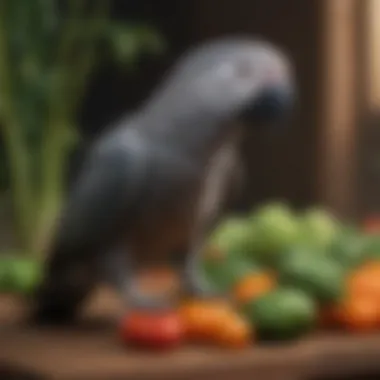Understanding the Dietary Preferences of African Grey Parrots


Intro
Care Tips
Taking good care of African Grey Parrots involves following certain daily routines. It is vital to have an organized approach to their feeding, cleaning, and social needs.
Daily Care Routines
Daily routines should include providing fresh food and clean water for your parrot every day. Monitoring food intake is important to detect any appetite changes that can indicate underlying health issues. A schedule fostering interaction will help combat boredom and encourage good mental health.
Cage Setup and Maintenance
The setup of the cage is fundamental as African Grey Parrots are social creatures. The enclosure should be spacious, offering various perches at different heights. Additionally, it is crucial to maintain cleanliness by regularly checking and cleaning food and water containers to promote good hygiene.
Hygiene and Cleaning Practices
Regular hygiene practices can significantly reduce the risks associated with illness. Clean your parrot's living area frequently, removing droppings and uneaten food promptly. On a weekly basis, ensure that cleaning solutions are bird-safe, avoiding toxic options like bleach.
Seasonal Care Adjustments
Seasonal variations can impact the health and behavior of your African Grey Parrot. In colder months, ensure adequate warmth in their environment. During hotter weather, ensure ample hydration. You could also adjust food offerings based on seasonal availability.
Behavioral Insights
To nurture health throughout the life of your African Grey, understanding their behaviors is crucial.
Understanding Bird Body Language
Birds communicate primarily through body language, which is insightful. For example, a puffed-up appearance typically indicates discomfort while a preening parrot often reflects relaxation. Additionally, observing vocalizations can also provide essential cues about their emotional state.
Common Behavioral Issues and Solutions
On occasion, these parrots may exhibit destructive behavior or aggressive tendencies. Solutions can often be found within environment adjustments. Providing ample activities and mental stimulation can redirect negative behaviors.
Positive Reinforcement Techniques
Utilizing positive reinforcement can improve behavioral responses. Rewarding desired behaviors with treats or affection can implement a more cooperative companion to engage with. This nurturing approach fosters a better human-bird relationship.
Social Interaction Needs
As social beings, African Greys need time with their owners. Encourage interaction through conversation or gentle play to build a bond that supports emotional well-being.
Nutrition Guides
Particularly regarding diet, understanding the essentials is vital.
Essential Diet Components
An ideal diet should emphasize a mixture of fruits, vegetables, and quality pellets. Selecting fresh, untained food sources will promote a vibrant diet. Well-known brands like Zupreem or Harrison's can provide excellent base pellets, while incorporating fresh produce enhances nutrition.
Safe and Toxic Foods
Certain foods can be detrimental to parrot health. For example, avocados and chocolate are toxic and should always be avoided. Conversely, fruits like apple slices and bananas are excellent choices.
Supplements and Treats
While a balanced diet is fundamental, considering supplements may be necessary to fulfill specific nutritional gaps. Researching guidance from a vet is recommended before making alterations to ensure they compliment existing feeding practices.
Feeding Strategies for Different Species
Consider adaptations based on the age and species of your parrot. Younger birds may require more protein, while adults thrive on a lower-fat regimen. Following diverse feeding strategies is essential to cater to unique needs.
Wellness and Health
Maintaining overall health is an ongoing responsibility inherent in keeping an African Grey parrot. Routine health checks, small observations, and preventative measures all contribute toward this task.
Routine Health Checkups
Regular vet check-ups reveal vital aspects of health, offering opportunities to track growth and behavioral changes. Early detection can often significantly reduce health complications.
Identifying Symptoms of Illness
Symptoms such as ruffled feathers, lack of appetite, and changes in vocalization warrant investigation. Recognizing and acting on these signs is crucial for continued health and happiness.
Preventative Care and Vaccinations
Ensuring the administration of necessary vaccinations and preventative care treatments commonly suggested by veterinarians informs a health-focused lifestyle for your pet. Staying up to date is crucial to keep your parrot protected.
Mental and Emotional Well-being


In tandem with physical health, consider methods that support mental acuity. Regular mental stimulation, along with social interactions, provides cognitive engagement contributing to overall well-being.
Enriching Activities
Lastly, providing diverse activities secures a healthy mind and body.
Toys and Playtime Ideas
Choosing toys appropriate for their beak and size can serve to alleviate boredom. Look for options that interest and challenge your bird. Chew toys and puzzles rate highly on the engagement scale.
Training and Tricks
Training sessions can bring opportunities for learning new tricks, enhancing focus and energy levels, making them incredibly enjoyable for both the loving owner and the parrot.
Outdoor Activities and Interaction
Supervised outdoor time benefits parrot well-being and creates an avenue for enriching interaction. Refreshing air and new scenery spice their environment.
DIY Projects for Mental Stimulation
Crafting homemade foraging activities not only saves money, but also brings creativity into playtime. Materials such as cardboard and paper towel rolls can be transformed into fun toys to stimulate your parrot's mind.
Understanding their diet and care requirements is fundamental to raising a healthy and fulfilling companion.
Understanding your African Grey Parrot is a multifaceted journey comprising of learning what they eat, providing care, and recognizing their emotional and material needs. Hence, always keep in mind that providing the best care nurtures both health and companionship.
Intro to African Grey Parrots
Overview of the Species
African Grey Parrots are highly intelligent and social birds known for their ability to mimic sounds and human speech. This species, including the Congo and Timneh varieties, showcases remarkable cognitive abilities. They form strong social bonds with their owners and may exhibit bonding behaviors in captivity. Their feathers are predominantly grey, with bright red or maroon tails, which make them visually distinctive.
Natural Habitat and Diet in the Wild
In the wild, African Grey Parrots inhabit rainforests and savannas throughout Central and West Africa. Their diet primarily consists of fruits, seeds, nuts, and certain vegetables, with a particular preference for soft and fleshy fruits. The natural search for food in trees and underbrush allows these parrots to consume their preferred items.
Their wild diet varies with seasonal changes. Depending on what is available, they adapt and moderate their intake. This flexibility is essential for their survival. When replicating their diet in captivity, knowing their habitat and natural dietary habits is key for maintaining their health. Being aware of where our feathered companions come from enchances the feeding resourcefulness of any bird enthusiast.
Key Nutritional Requirements
Understanding the key nutritional requirements of African Grey Parrots is fundamental to their overall health and well-being. African Grey Parrots are known for their intelligence and social behavior, making it crucial for pet owners to provide them with a well-rounded diet that meets their nutritional needs. This section delves into two primary aspects: macronutrients and the essential vitamins and minerals that drive their bodily functions and safeguard their health.
Macronutrients Essential for Health
Macronutrients play a vital role in the day-to-day health of African Grey Parrots. These nutrients give them the energy they need to be active and maintain proper physiological functions. The three main macronutrients are carbohydrates, proteins, and fats. Each of these super vital nutrients perform distinct functions.
- Carbohydrates: These provide energy. Natural sources, such as fruits and certain grains, deliver readily digestible energy that parrots require for activities. Balanced carbohydrate intake promotes a healthy metabolism.
- Proteins: Proteins are fundamental for growth, tissue repair, and supporting a healthy immune system. High-quality protein sources include legumes, cooked eggs, and specific seeds. Parrots benefit greatly from diverse protein options as birds have unique proteins needs, which can fluctuate with age and health.
- Fats: Healthy fats support skin and feather condition, enhance energy levels, and add flavor to their diet. Nuts are a common fat source, supplying essential fatty acids. However, moderation is crucial; excessive fat can lead to obesity and associated health problems.
Overall, understanding these macronutrients and their balance empowers parrot owners to craft diets tailored to their birds’ unique profiles.
Vitamins and Minerals in Their Diet
Vitamins and minerals contribute to numerous functions in African Grey Parrots. They are integral for crucial processes, from collagen production to maintaining vision and optimal energy levels. Deficiencies can result in adverse health conditions, underscoring the importance of an intake focusing on a variety of nutritious food sources.
Here are some essential vitamins and minerals:
- Vitamin A: Crucial for immune function and vision, this vitamin is often found in carrots, leafy greens, and peppers. Deficiencies cause respiratory issues and feather loss.
- Vitamin D3: This vitamin aids calcium absorption, critical for bone health. Exposure to appropriate sunlight or UV light in environments can assist in synthesizing D3.
- Calcium: Essential to support the skeletal system and muscle function. Calcium can be obtained from darker leafy vegetables and bones from safe sources.
- Sodium and Magnesium: Both electrolytes support cellular functions and metabolic processes. These minerals are found in varying levels of natural seeds and nuts.
To enhance the nutritional profile and prevent deficiencies, owners should offer a variabil diet comprising fruits, vegetables, seeds, and specially formulated pellets.
A diverse diet ensures different dietary needs are met fundamentally, protecting against nutritional deficiencies that can harm health and longevity.
Being aware of these key nutritional elements ensures that owners can make informed decisions, contributing directly to the well-being and longevity of their African Grey Parrots.
Types of Foods African Grey Parrots Prefer
The dietary choices of African Grey Parrots play a significant role in their wellbeing and longevity. Understanding the types of food these birds prefer can help pet owners create an appropriate and appealing diet. A balanced intake of different food groups ensures that birds receive all the necessary nutrients.
By diversifying the food types, owners can prevent nutritional deficiencies, boost mental stimulation, and enhance social interaction with their pets as they explore various textures and flavors.
Fruits Recommended for African Grey Parrots
Apples: Benefits and Precautions
Apples are a favored fruit among African Grey Parrots. They are packed with essential vitamins such as Vitamin C and dietary fiber, which support overall health. However, it is important to remove seeds, as they contain cyanide, which can be toxic to birds in high quantities.
Ensure that apples are washed thoroughly to remove pesticides. Moderation is key, as too much apple may cause stomach upset.
Berries: Nutritional Value


Berries, including strawberries, blueberries, and raspberries, provide a wealth of antioxidants and vitamins. They promote a healthy immune system, which is vital for active parrots. These fruits are low in sugar and can help maintain the bird's ideal weight.
Despite their benefits, berries should be served fresh and not in processed forms, which often contain added sugars. Variations in berry types keep the diet interesting.
Citrus: Impact on Health
Citrus fruits such as oranges and grapefruits offer high levels of Vitamin C, boosting the immune system of African Grey Parrots. Their tangy flavor is often a hit, encouraging regular hydration. However, excessive citrus can upset the balance of calcium, potentially causing issues if not measured.
Including citrus occasionally can provide lively health benefits but ensure it doesn't dominate their fruit intake.
Vegetables That Suit Their Taste
Leafy Greens: Digestive Benefits
Leafy greens, like kale and spinach, deliver high fiber content, which greatly aids digestion for African Grey Parrots. These vegetables also contain important minerals and vitamins. Darker greens are often richer in nutrients.
Steaming them lightly can enhance palatability without losing nutrients, making them an excellent choice for parrots. Get them into the diet several times a week but change things up to keep their interest.
Root Vegetables: Nutritional Profile
Root vegetables—like carrots and sweet potatoes—are energy-rich choices. They are known for their natural sugars, providing necessary energy for active birds. Carrots contain vitamins such as A and beta-carotene.
Cook or chop them finely to enhance digestibility. Overcooked veggies can lose vital nutrients, which can be a drawback if prepared incorrectly.
Cooked Vegetables: Safe Serving Suggestions
Offering cooked vegetables can encourage acceptance, as some parrots prefer softer textures. Steamed or boiled veggies retain their nutritional value while being easier to eat.
Introduce a variety of colors, textures, and flavors to provide a rich diet. Avoid adding salt or spices since those can harm a bird’s health.
Seeds and Nuts Considerations
Diverse Seed Mixes: Pros and Cons
Seed mixes designed for African Grey Parrots can provide a mix of essential nutrients. Different seeds contribute various fatty acids and protein that support overall health. However, some seed mixes are high in fat, requiring careful selection.
Consider a varied diet—mixed seeds—paired with fresh fruits and vegetables instead of serving only seeds, to prevent obesity.
Safe Nuts and Their Nutritional Impact
Nuts can be a source of high energy, fats, vitamins, and minerals. Safe nut options include almonds and walnuts. They should be offered sparingly due to their fat content, yet they can help improve feather quality and support skin health.
Raw, unsalted nuts offer better nutrition than their processed or salted counterparts—it’s essential to monitor portion sizes to maintain a healthy weight.
Grains and Pellets: A Balanced Choice
Commercial Pellets: Ingredients to Look For
Commercial pellets designed for African Grey Parrots provide a balanced meal. Key ingredients should include whole grains, protein sources, vitamins, and minerals. It’s crucial to avoid pellets with artificial colors or preservatives—opt for brands focused on natural ingredients.
Focusing on quality nutrition in pellets ensures that all dietary needs are met when layered with fresh foods.
Cooked Grains: How They Benefit Health
Cooked grains, such as quinoa, brown rice, or oatmeal, are nutritious additions. They are rich in fiber and beneficial for digestion. Heating grains enhances their flavors and makes them palatable to birds.
Incorporating different grains can introduce diversity and assure that their meals remain appealing while meeting various nutritional needs.
Understanding Food Preferences and Behaviors
Understanding how African Grey Parrots choose their foods and their behavioral patterns associated with eating is crucial for avian caretakers. These parrots are intelligent and socially complex. Their dietary preferences may also result from instinct and learning driven by their environments. Grasping the nuances of food preference can assist in creating suitable meal plans that align with the specific needs of the birds. This not only promotes health but emphasizes overall well-being for these remarkable creatures.
Factors Influencing Dietary Choices
African Grey Parrots exhibit specific preferences that arise from aI interplay of various factors. These factors include inherent instincts, learned behaviors, and environmental considerations.
- Nature of Instincts: Like many birds, African Grey Parrots have evolved to seek out nutrition based on instinct. In the wild, their intelligence is reflective of their survival strategies.
- Learned Behaviors: Alongside genetic predispositions, these parrots learn from their environment. Exposure to certain foods can trigger preferences that last a lifetime. Observing other birds in captivity or engaging with their caregivers fosters a connection that can affect their food selection.
- Personal Experience: The individual experiences of each bird determine preferences too. Birds may have dislikes for certain foods based on past experiences. Negative reactions to unfamiliar foods often lead to avoidance in the future.
Social and Environmental Impacts on Eating Habits
The social and environmental context plays a significant role in shaping an African Grey Parrot's eating habits. The interaction within a flock can greatly influence individual dietary choices; for those kept as pets, interaction with humans becomes crucial.
Health Risks Arising from Poor Diet
African Grey Parrots are remarkable creatures requiring specific nutritional guidelines to thrive. Recognizing the health risks that emerge from an inadequate diet is crucial for bird owners seeking to foster their parrot's well-being. Without a balanced diet, these intelligent birds may suffer from various health issues that compromise their longevity and quality of life.
One method to reduce these health risks involves understanding essential dietary components. Many parrot owners might overlook the significance of nurturing a diverse diet. A balanced meal plan minimizes ailments associated with poor nutrition. Thus, it warrants detailed discussion regarding common deficiencies and signs of dietary imbalance.
Common Nutritional Deficiencies


African Grey Parrots, like any other animal, necessitate a variety of nutrients for optimal health. When they lack essential vitamins or minerals, they may experience nutritional deficiencies that affect their development and functionality.
Vitamin A deficiency is notably common in parrots fed primarily seed diets. Vitamin A aids in maintaining skin, feathers, and respiratory health. Symptoms may include dull feathers, frequent infections, and even failure to thrive. Additionally, calcium deficiency can lead to reproductive issues in breeding females and can even jeopardize bone structure.
Some of the more common deficiencies include:
- Vitamin A
- Calcium
- Vitamin D3
- Essential fatty acids
- Vitamin B12
Addressing these deficits involves incorporating foods naturally rich in these nutrients, such as dark leafy greens, fortified pellets, and sunflower seeds. Regular monitoring of your bird’s condition can signal incorrect perceived counts in these vital areas.
Signs of Dietary Imbalance
Recognizing the clues that indicate improper feeding can be challenging but necessary. Owners must remain vigilant regarding behavioral changes and physical signs. Parrots exhibit outward indications to signal disproportions in their diets.
Signs may manifest as:
- Change in plumage quality: Rough or faded feathers signal deficiencies or an unbalanced diet.
- Weight fluctuations: Overweight or underweight situations suggest dietary issues.
- Altered social behaviors: Lethargy, irritability, or excess aggression can occur due to imbalanced or inadequate nutrients.
- Health issues: Frequent respiratory problems, infections, or illnesses can trace back to bad nutrition practices.
To prevent these signs from escalating, bird owners should prioritize assessing their pet's dietary intake regularly. Ensuring snacks and meals contain essential nutrition sees improved outcomes for African Grey Parrots.
Proper nutrition is more than just feeding; it’s an ongoing commitment to your bird's health and longevity.
Integrating awareness of nutritional deficienciees and symptoms of dietary imbalance empowers owners to build healthier diets for their feathered companions. Understanding these risks ensures that struggling parrots receive appropriate care timely. Through considered actions or consultations with avian vets, owners ensure that they meet these essential needs effectively.
Tips for Feeding African Grey Parrots
A well-considered feeding approach can greatly improve the well-being of African Grey Parrots. Understanding their dietary preferences helps owners make informed decisions about suitable food options. Feeding practices directly influence the birds' health and happiness. This section highlights essential strategies for nutrient balancing, presenting information that all responsible bird owners should know.
Creating a Balanced Meal Plan
A balanced meal plan is imperative to provide all necessary nutrients that African Grey Parrots need. It should consist of fruits, vegetables, grains, and protein sources. Establishing this balance can help prevent health issues.
- Fruits should make up around 10-20% of their diet. Good choices include apples, bananas, and various berries.
- Vegetables can comprise around 30% of the diet, focusing on leafy greens like spinach and kale.
- Grains and pellets should represent another 30-40%, incorporating colorful pellets that are specifically designed for pet birds.
It is also helpful to adjust portions based on individual activity levels and age. Customization accounts for personal preferences, which is an important aspect to consider. Don’t forget to avoid foods high in sugar or unhealthy fats that can lead to diet-related problems.
The Importance of Varied Diet
A varied diet goes beyond nutritional needs; it also tackles spontaneity in feeding routines. African Grey Parrots are intelligent creatures that can become bored easily. Providing a variety of tastes and textures keeps them engaged.
Advantages of including variety:
- Stimulates foraging instinct: Different textures and flavors encourage natural foraging behavior.
- Prevents boredom: Diverse foods help prevent behavioral issues that often arise from monotony.
- Ensures comprehensive nutrition: Diverse food choices reduce the chances of any specific nutrient deficiencies.
Some recommended foods for diversification are:
- Various seeds (in moderation)
- Nuts (without salt or sugar added)
- Special commercial pellets tailored to meet avian nutritional needs
This variety not only enriches their dietary experience but also nurtures mental stimulation.
Monitoring Dietary Intake and Health
Keeping a close eye on your parrot’s dietary choices is as crucial as selecting those foods. Regular monitoring ensures they are receiving the right balance of nutrients for optimum health.
Actions to include when tracking their diet:
- Weight checks: Regular weighing of your parrot can indicate any sudden shifts in health. Weight loss may signal dietary inadequacies.
- Observation of feces: Healthy droppings replicate a healthy diet. Changes in color or consistency may indicate inappropriate food intake.
- Health assessments: Schedule vet check-ups regularly to discuss diet and nutrition, focusing on any visible changes in plumage or behavior.
Keeping track of your parrot’s dietary habits promotes long-term health and allows for immediate intervention if necessary.
In summary, vibrant feeding habits inline with a strategic meal plan are key elements in fostering the overall health of African Grey Parrots. Strategic choices may significantly affect their vitality while maintaining this species' unique traits and intelligence.
End: Ensuring Optimal Nutrition
Ensuring optimal nutrition for African Grey Parrots plays a critical role in the overall health and longevity of these intelligent birds. Their unique dietary requirements necessitate a careful approach to feeding, where macronutrients, vitamins, and minerals form the foundation of a balanced diet. This article emphasizes that the right dietary choices extend beyond mere taste preferences. Several factors should anchor food selection, including nutritional content, safety, and variety.
Optimal nutrition allows African Grey Parrots to thrive, fostering physical well-being, energy levels, and cognitive function. Adequate intake of grains, fruits, and specially formulated pellets reinforces their immune system and minimizes health risks. A thoughtful blend of these food types not only benefits digestion but also satisfies natural instincts.
- Highlights of dietary essentials:
- Diverse food sources reduce the risk of deficiencies.
- Fibrous and nutrient-dense foods promote digestive health.
- Calcium-rich ingredients are crucial for maintaining strong bones and overall vigor.
Each owner must gain knowledge about their chosen fereder's preferences, taking into account what foods enhance their lives while meeting daily nutritional needs.
Summarizing Dietary Essentials
Species-specific considerations reveal that fresh fruits, vegetables, and quality commercial pellets are equally important. These staple ingredients should dominate their diet. The right combination, made with knowledge and love, translates directly into the vibrancy of your African Grey's life, affecting everything from mood to longevity.
A crucial part of this balanced diet includes understanding appropriate amounts. With proper portion control, overindulgence can become a dangerous issue. Avian enthusiasts need to stay aware of their birds’ physical reactions to foods, prioritizing signs of comfort and well-being regularly.
Final Thoughts on Avian Nutrition
Final thoughts on avian nutrition emphasize the individual nature of each bird's requirement. It's often necessary for owners to experiment with different combinations of foods, observing how their birds respond to each accordingly. Attention to diet should not be a one-time effort; rather, topics of nutrition are ongoing endeavors.
Evaluating new food sources, tending to portions, experimenting with textures, and being responsive to reactions promotes a supportive feeding environment.
Overall, finding a healthy balance of various food types permits African Grey Parrots to express their natural behaviors in captivity and economize on needed nutrients. With structured awareness of their unique needs, bird owners will establish the paths towards joy that each African Grey deservess. Regular updates from trusted avian resources online such as Wikipedia, Britannica, and community discussions on Reddit provide excellent opportunities for learning more about enhancing your parrot's life through diet.















